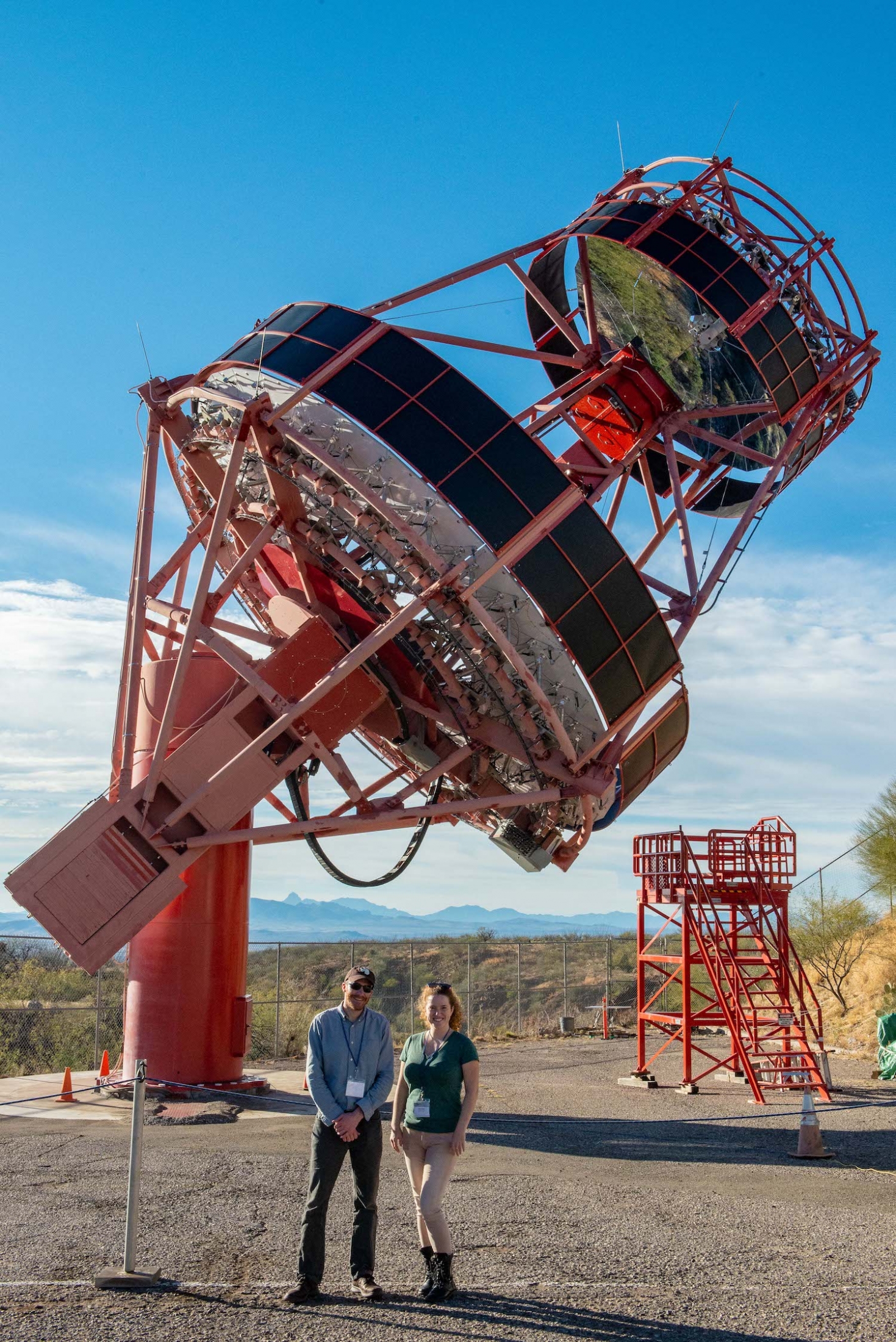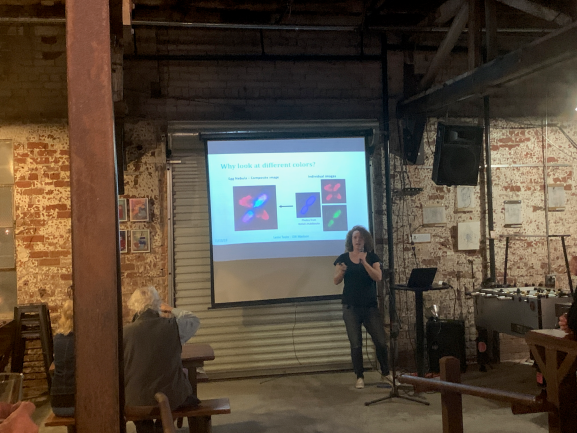While Wisconsinites endured another Midwestern fall and winter—one that, while relatively mild, included a snowstorm on Halloween—University of Wisconsin–Madison graduate student Leslie Taylor was basking in the Arizona sun. Her research group needed her to lead commissioning and other hands-on work with the prototype Schwarzschild-Couder telescope (pSCT) at the Fred Lawrence Whipple Observatory on Mount Hopkins, 35 miles south of Tucson. So Taylor got to escape the harsh Madison weather and head to the Southwest, where she lived and worked from September 2019 to January 2020.
“I love working out there. It’s warmer than Madison; it’s exciting,” says Taylor. “I like hands-on hardware stuff, so it’s perfect, being on-site.”
The pSCT is a prototype medium-sized telescope for the Cherenkov Telescope Array (CTA) project, an array that will be made up of 118 small-, medium-, and large-sized telescopes across two sites: one near Paranal, Chile, and one on the island of La Palma in the Canary Islands.
Professor Justin Vandenbroucke leads the CTA group at UW–Madison’s Wisconsin IceCube Particle Astrophysics Center (WIPAC). For the last seven years, the WIPAC CTA team has worked, along with collaborators, on the construction and integration of the pSCT’s high-speed camera—which is the size of a golf cart, weighs 800 pounds, and is capable of recording movies at a billion frames per second. Assembly and testing of the camera was completed in their Madison lab in early May 2018, and it was shipped to Mount Hopkins and installed on the pSCT at the end of that month.

Taylor has worked with Vandenbroucke for three years now, so this trip wasn’t her first time at the Whipple Observatory; she has been there on and off for a couple of weeks at a time, including in January 2019 when she recorded “first light” and first particle showers with the telescope a few days after its inauguration. The camera recorded these first particle-induced air showers within seconds of being powered on for the first time with the telescope’s mirrors uncovered.
While Taylor was stationed at Whipple last fall, she worked three different shifts: day, swing, or night. Day shift was mostly hardware work or analysis work, like a typical “office job.” Swing shift involved doing things like testing the camera to make sure that software was running properly or that it was collecting data for analysis, which required waiting until it got dark outside. Night shift work was actually taking data.
For the first two months, Taylor did mostly commissioning work: preparing, fixing, and verifying things were working as well as coordinating with the optics team to align the mirrors. She also did an observing shift for VERITAS (Very Energetic Radiation Imaging Telescope Array System)—an existing array of four single-mirror telescopes at the Whipple Observatory—to learn about how they do their shift operations in order to help establish one for the pSCT.
The latter two months involved more commissioning and testing as well as the first routine data-taking campaigns with the pSCT pointing at the Crab Nebula.
The Crab Nebula is the gold standard for very high energy gamma-ray observations. This supernova remnant—the cosmic gas and dust left over after a star has exploded almost a thousand years ago, leaving behind a neutron star—is a bright and constant source of such gamma rays. It’s usually the first object that very high energy gamma-ray telescopes look toward because, if the telescope detects it, scientists know that all aspects of the telescope are working properly.
Using data recorded between January and March 2020, the pSCT detected the Crab Nebula with 8.3-sigma statistical significance. Vandenbroucke announced the detection on behalf of the CTA Consortium at the 236th Meeting of the American Astronomical Society.
The pSCT’s observations of the Crab Nebula were coordinated with VERITAS, which enables powerful comparisons between VERITAS’s proven and well-characterized technology and the novel technology of the pSCT. This includes estimating the gamma-ray energy threshold of the new telescope and using VERITAS to tag events as “gamma-like” or “hadron-like.” This trains and validates the pSCT’s gamma-hadron separation. “Hadron showers look a bit like gamma-ray showers, so it’s important to effectively differentiate between them in order to say that we saw a gamma ray,” says Taylor.
Other milestones from Taylor’s on-site work include the installation of a new LED flasher, restructuring and simplification of data-taking software, characterization and understanding of temperatures and rates, and the installation and initial testing of a GPS time-tagging system.
Taylor also did some outreach, giving a public talk on the basics of gamma-ray astrophysics and telescopes at “Space Drafts,” a local chapter of Astronomy on Tap, at a local bar and brewery.

In addition, while at the Whipple Observatory, Taylor established the observing procedure for the pSCT and then helped train other observers, who continued taking data until the observatory shut down in March due to the COVID-19 pandemic.
According to Vandenbroucke, “Leslie’s work during her four months on-site as well as her previous trips to the observatory and her work integrating and testing the camera in the lab on campus were essential to achieving routine operations of the pSCT, which led to the major milestone of detecting the Crab Nebula with this new type of telescope.”
Taylor returned to Madison in January where, ideally, she will continue spending most of her time. “Especially now that we have done initial observations, I am shifting away from hardware stuff and more toward analysis and writing my thesis,” she says.
Read the press release from WIPAC here.
The pSCT project is made possible by funding provided by the U.S. National Science Foundation, by the contributions of other U.S. partner and international funding agencies, and by the efforts of thirty institutions and five key industrial partners across the United States, Germany, Italy, Japan, and Mexico. The full list can be found here. At UW–Madison, the Office of the Vice Chancellor for Research and Graduate Education and the Wisconsin Alumni Research Foundation have supported the project through a UW2020 award.
